Paslow Building’s History Still Haunts Downtown Belize City
Tonight, we’re taking a look back at a building that once stood tall in downtown Belize City; iconic, controversial, and unforgettable. The Paslow Building wasn’t just bricks and mortar, it carried the weight of colonial history and a name tied to a dark legacy. Thomas Paslow, celebrated by some for defending Belize in 1798, was also condemned for his role as a slaveowner. That legacy lived on through the building that housed government offices for decades, until a fire in 2002 reduced it to ashes. Today, the site has been reborn as Belize Heritage Plaza, a symbol of a more inclusive future. But the debate over its past still lingers. Here’s this week’s Belize on Reel feature.
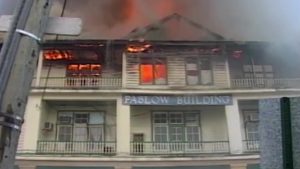 Tanya Arceo, Reporting
Tanya Arceo, Reporting
Right at the corner of Queen and North Front Streets, a building once stood that anchored downtown Belize City, the Paslow Building. That all changed in 2002 when a fire wiped it out, but the story behind the name still sparks debate. Today, the site has been redeveloped and serves government services, but the legacy of Thomas Paslow, a man tied to both colonial defense and slavery, continues to raise questions. To unpack the history and the meaning behind what stands there now, we spoke with Giovanni Pinelo, Public History Officer at ISCR–NICH. He breaks down the era Paslow lived in, the building’s role in civic life, and how memory and heritage shape the space today.

Giovanni Pinelo
Giovanni Pinelo, Public History Officer, ISCR-NICH
“Thomas Paslow one of the Baymen a building was named after him in Belize Town but the reality also has to be looked at from the humanistic the human perspective who was Thomas Paslow beyond one of those prominent settlers we know for a fact that he owned quiet a number of logging camps in Belize for example along the Belize River, you can find even to this day a number of spot that he had Big Falls in the area of Big Falls and that is coming form Belize River mull towards the west, at beaver dam he had claimed a large portion of land there and further south if you go to Bullet Tree Falls there is a section of the river known as Paslow Falls and as you continue up the Mopan river where you and I originally come from there is the Clarissa Falls which the Galvez family owns and Chena Galvez runs that tourist destination Clarissa Falls, Clarissa was actually Paslows wife she was of afro descent and as his wife she also owned enslaved Africans so Paslow was an enslaver.”
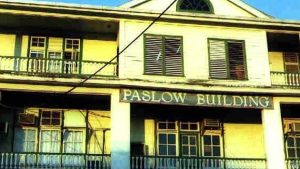
The Paslow Building
While some may look back on Thomas Paslow as a prominent figure, Pinelo stresses that Paslow’s role as magistrate revealed a far darker side. He enforced brutal punishments against enslaved Africans, a reminder that his legacy is rooted not only in wealth and influence, but also in cruelty.
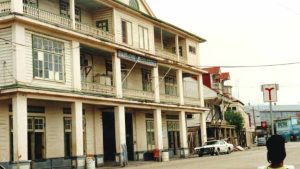 Giovanni Pinelo
Giovanni Pinelo
“As a magistrate he was one of the judges in several of the court actions in which enslaved Africans were involved and meting out punishment against the enslaved was nothing easy I mean it went from thirteen lashes with a cattle nine tails you know the cattle nine tails being a short whip with leather straps and metal tips at the end so they their judgement was often like that in fact there’s a story of he himself taking a couple of his own enslaved Africans to court and after their punishment they were supposed to come back to work with him.”
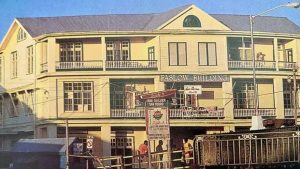 Built in the 1920s, the three-story wooden structure reflected the colonial architecture of its time. It initially housed a general store, later served as the city’s main post office by the 1940s, and eventually became a key hub for justice and governance.
Built in the 1920s, the three-story wooden structure reflected the colonial architecture of its time. It initially housed a general store, later served as the city’s main post office by the 1940s, and eventually became a key hub for justice and governance.
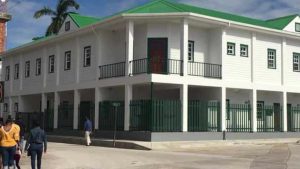
“Ground Zero”
Giovanni Pinelo
“Between 1920 and 1922 they would construct what became known as The Belize Stores, The Belize Store was the first three storey building to be constructed in Belize The Jefferson Construction company was also they had also gotten the contract to fill in the portion of what was a creek that joined Fort George which was also an island and there was a creek or a water way between the mainland by St Mary’s church around Gabriel Lane that was once water and so it was refilled the Jefferson Construction Company from New Orleans gets the contract and they do that building they also had constructed they reconstructed the public buildings which are next to the Supreme court they also did the reconstruction of the Supreme Court which had burned down in 1918. In 1942 just at the turn of World War II let me back track a little The Belize Stores was probably the modern mall of 1920s the idea as the name implies was for it to have different spaces where different types of goods were being sold.”
By the 1940s, Paslow Building had become Belize City’s main post office, a role it carried for decades before housing the Magistrate’s Courts and other public services. That history came to an abrupt end with the devastating fire of 2002, which left the structure in ruins and the site dubbed “Ground Zero” in the heart of downtown. In the years that followed Ground Zero was redeveloped into what is now the Belize Heritage Plaza, home to the Lands and Surveys Department and other government offices. Tanya Arceo for News Five.






Facebook Comments